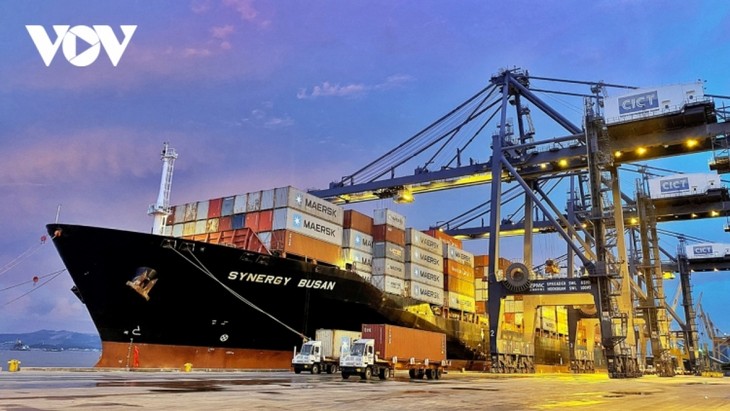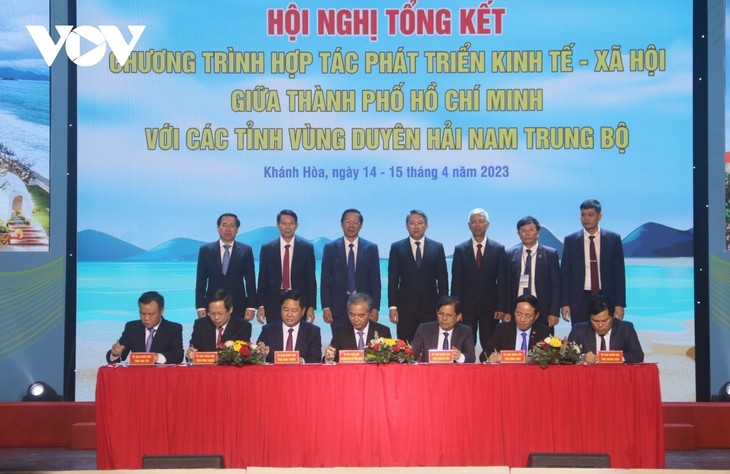(VOVWORLD) - Developing regional links is a consistent policy of the Party and State to tap the potential and advantages of regions and localities nationwide to serve national socio-economic development, ensure defence and security, and improve people’s lives.
 Large-scale logistics centers are expected to be built in Hai Phong, Quang Ninh, Hanoi, and Hai Duong. Large-scale logistics centers are expected to be built in Hai Phong, Quang Ninh, Hanoi, and Hai Duong. |
The Red River Delta is a vitally important area in Vietnamese politics, economy, culture, society, and foreign affairs.
The capital city of Hanoi, the center of the region and one of Vietnam’s two economic hubs, has achieved a breakthrough in transport and logistics infrastructure by connecting, cooperating, and exchanging with other localities in the region.
Le Viet Nga, Deputy Director of the Domestic Market Department of the Ministry of Industry and Trade, said she believes that to see stronger socioeconomic growth, provinces need to promote linkages.
“There remain areas that regional connectivity has missed. Under the Prime Minister’s decision released in 2015, the Red River Delta will have a level-1 logistics center in northern Hanoi, a level-2 logistics center in southern Hanoi, and, by 2030, logistic centers will cover 50 hectares near airports and seaports in the region. But we haven’t seen these logistics centers yet. We need to link localities to attract investment,” said Nga.
Vietnam has six socio-economic regions – the northern midland and mountain region, the Red River Delta, the northern and central coastal, the Central Highlands, the southeastern region, and the Mekong Delta.
Over the years, regional links have been improved through joint organization of trade fairs and exhibitions, regular meetings and forums, creation of a regional web portal, and the signing of regional and bilateral cooperation agreements.
 Ho Chi Minh City and six coastal central provinces agree to establish a regional advisory council. Ho Chi Minh City and six coastal central provinces agree to establish a regional advisory council. |
Tran Van Hao, Director of Hai Duong province's Department of Industry and Trade, says these changes were a result of government policy improvement, but to make the regional links a success, localities and regions need to develop infrastructure, especially transportation infrastructure.
Hao called on ministries, sectors, provinces, and cities to speed up the construction of transportation projects to strengthen regional linkages and create industrial belts, inter-sectoral clusters, and industrial and service ecosystems.
“It’s necessary to invest in new logistics infrastructure and the expansion of existing logistics centers in Hai Phong, Quang Ninh, Hanoi, and Hai Duong to reduce costs for businesses, improve competitiveness, and motivate the entire region’s development,” Hao added.
Associate Professor Dr. Tran Dinh Thien, former Director of the Vietnam Institute of Economics, underscored the importance of businesses’ cooperation and establish a regional advisory council with strong power, good resources, and a highly effective mechanism.
According to Thien, after a regional linkage is set up, it’s necessary to build a production structure, also known as industry linking clusters, to connect provinces.” Thien explained, “The vision for the region is to create clusters of industry development. The economic structure itself will force businesses which invest in the region to work with each other. A second issue relates to institutions. For a long time, what we had was separate geographical areas rather than one area for cooperative development.”
Nguyen Thi Bich Ngoc, Deputy Minister of Planning and Investment, said the most important thing is to improve the institutions and investment environment of each locality, region, and inter-region to attract investment for building a modern, convenient regional infrastructure.
“The Government annually promulgates resolutions on improving the business investment environment, which localities in the region need to effectively implement to reform administrative procedures, offer the best conditions to attract investment in infrastructure, regularly organize investment promotion conferences by region, and create investment attraction projects under the Public-Private Partnership model until 2030,” Ngoc said.
The localities should offer incentives to attract private investment, thereby helping private businesses understand and have confidence when investing in infrastructure, Ngoc added.
Vietnam is revising its growth model, restructuring its economy, and improving its national competitiveness. Building development spaces at the regional level will provide additional impetus for regional and local development.